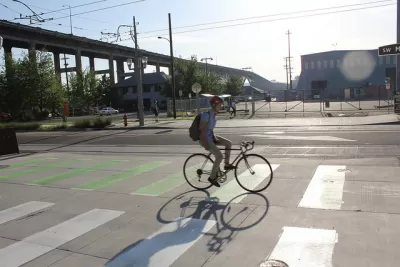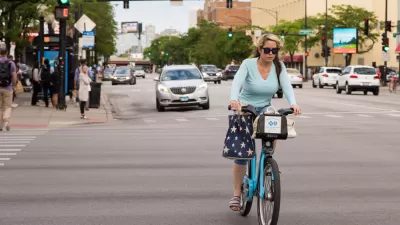Another study shows what should be obvious by now: the higher quality the bike infrastructure, the better the results in terms of safety and mode choice.

"A new study [pdf] published in the American Journal of Public Health has concluded that physical separation from motor traffic is “crucial” to reducing the higher than average cyclist injury rates seen across the U.S.," reports Mark Sutton.
The study collected evidence from Europe, ten cities and the United States, and an earlier study of Boston.
An editorial that accompanies the study [pdf] also states the following about the effect of infrastructure quality on safety outcomes:
It is crucial to provide physical separation from fast-moving, high-volume motor vehicle traffic and better intersection design to avoid conflicts between cyclists and motor vehicles. More and better bicycle infrastructure and safer cycling would encourage Americans to make more of their daily trips by bicycle and, thus, help raise the currently low physical activity levels of the US population.
The study's exhibit A is provided by Minneapolis, where the city "grew its cycle network by 113% between 2000 and 2015, delivering a 79% reduction in severe injuries per 100,000 cycle journeys," explains Sutton. "This also tallied with a 203% growth in cycling in the areas where safe infrastructure was present."
FULL STORY: Safer Cycling Through Improved Infrastructure [pdf]

Maui's Vacation Rental Debate Turns Ugly
Verbal attacks, misinformation campaigns and fistfights plague a high-stakes debate to convert thousands of vacation rentals into long-term housing.

Planetizen Federal Action Tracker
A weekly monitor of how Trump’s orders and actions are impacting planners and planning in America.

Chicago’s Ghost Rails
Just beneath the surface of the modern city lie the remnants of its expansive early 20th-century streetcar system.

Bend, Oregon Zoning Reforms Prioritize Small-Scale Housing
The city altered its zoning code to allow multi-family housing and eliminated parking mandates citywide.

Amtrak Cutting Jobs, Funding to High-Speed Rail
The agency plans to cut 10 percent of its workforce and has confirmed it will not fund new high-speed rail projects.

LA Denies Basic Services to Unhoused Residents
The city has repeatedly failed to respond to requests for trash pickup at encampment sites, and eliminated a program that provided mobile showers and toilets.
Urban Design for Planners 1: Software Tools
This six-course series explores essential urban design concepts using open source software and equips planners with the tools they need to participate fully in the urban design process.
Planning for Universal Design
Learn the tools for implementing Universal Design in planning regulations.
planning NEXT
Appalachian Highlands Housing Partners
Mpact (founded as Rail~Volution)
City of Camden Redevelopment Agency
City of Astoria
City of Portland
City of Laramie




























